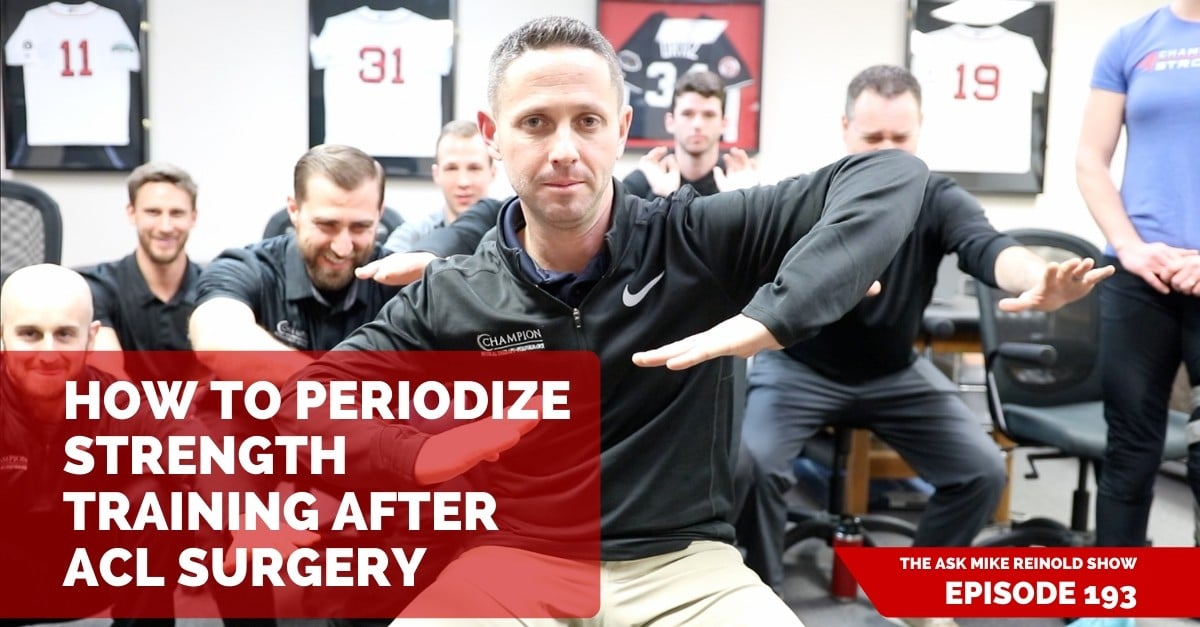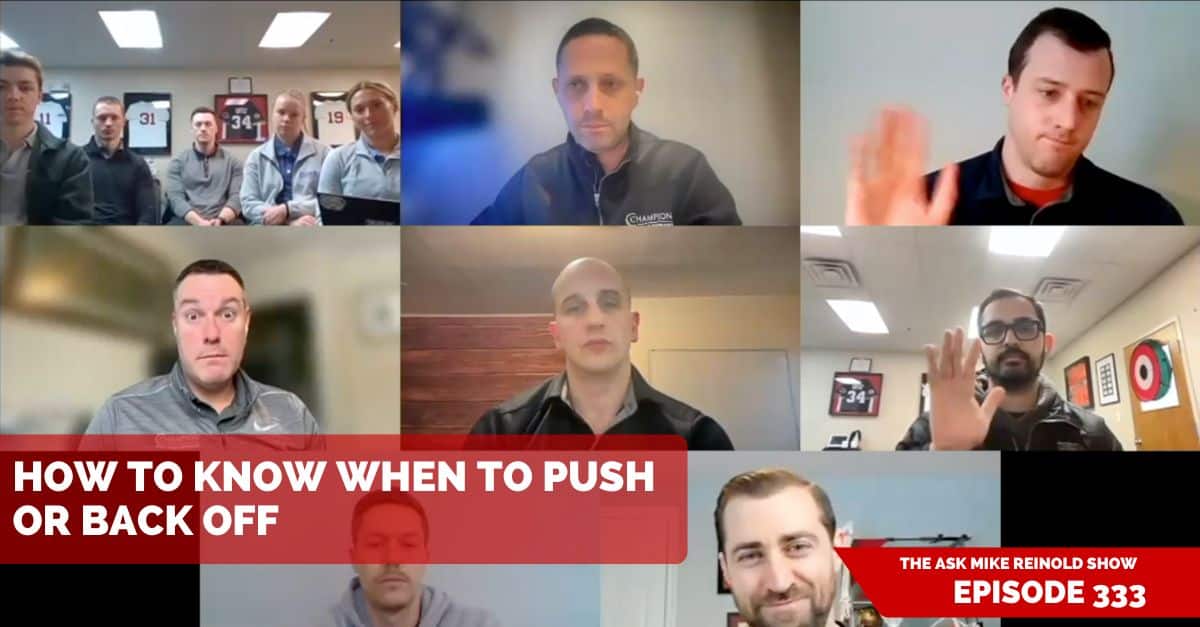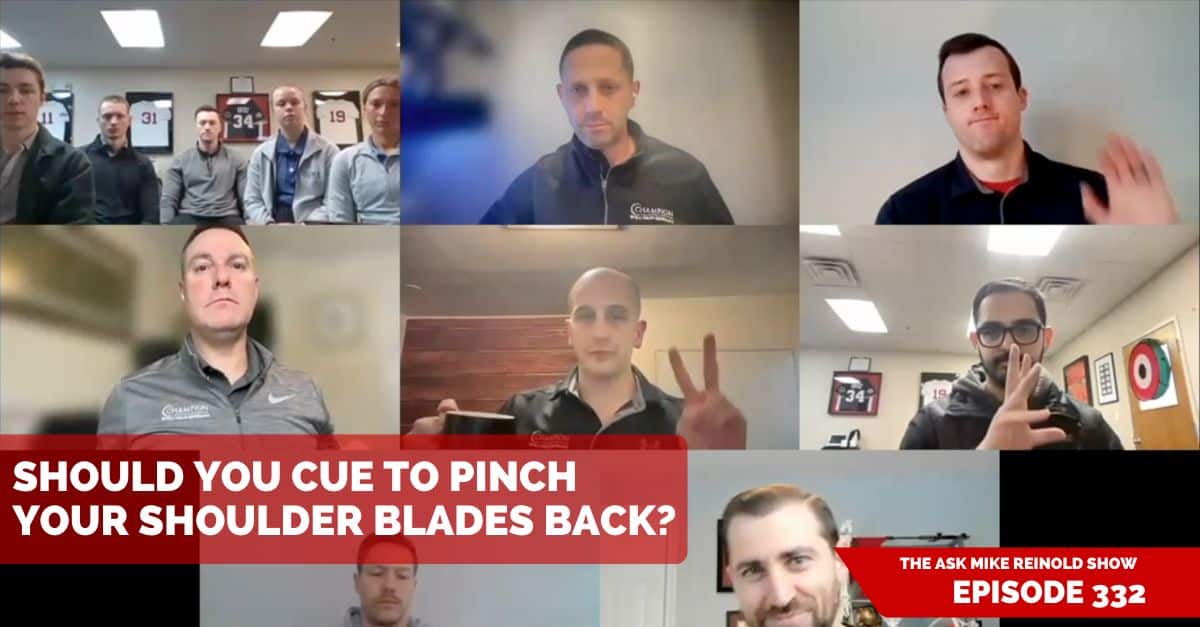On this episode of the #AskMikeReinold show we talk about how to periodize strength training after ACL surgery. We all know that it takes a long time for the strength to come back after an ACL, here’s how we tackle that with a more advanced periodization progression. To view more episodes, subscribe, and ask your questions, go to mikereinold.com/askmikereinold.
#AskMikeReinold Episode 193: How to Periodize Strength Training After ACL Surgery
Listen and Subscribe to Podcast
You can use the player below to listen to the podcast or subscribe. If you are enjoying the podcast, PLEASE click here to leave us a review in iTunes, it will really mean a lot to us. THANKS!
Show Notes
- ACL Reconstruction Rehabilitation Protocol
- 6 Keys to the Early Phases of Rehabilitation Following ACL Reconstruction Surgery
- Return to Play Testing After ACL Reconstruction
- The Science of Blood Flow Restriction Training
- Blood Flow Restriction Training Online Course
Transcript
Mike Reinold: On this episode of the Ask Mike Reinold show, we talk about how we periodize strength training after surgeries such as ACL reconstruction.
(Intro)
Mike Reinold: Austin, what do we have for a question today?
Student: All right, we got Dan from Minnesota.
Student: “You’ve talked several times on your podcast about certifications to learn about weight training and becoming proficient at learning those movements. What about periodization principles for a post-op ACL? How do you periodize a strength program to get a quad back to 90%?”
Mike Reinold: We have talked a lot about physical therapists getting into weight training and how to do that, right? And there’s tons of ways to do it. Probably the best way is the fitness pain-free certification.
Dan Pope: Wow.
Lenny Macrina: Whoa.
Mike Reinold: No, but in full sincerity, yes, absolutely. But I like how you asked your question; it’s not about learning the lifts, it’s not about learning how to do them, how to coach them, how to fix them, how to optimize them, right? But it’s also about how to periodize them, which is more programming. So great question.
Mike Reinold: So how do we periodize, and I actually used ACL as an example, it’s good. How do we periodize a rehab strength training program?
Lenny Macrina: First I want to say, it was Dan from Minnesota, right? 90% quad return is not good enough, so rephrase the question or rethink your thoughts.
Mike Reinold: Wow.
Mike Scaduto: Wow.
Lenny Macrina: Because 90% – I don’t know where this is coming from in the world of PT, but 90% return to quads is-
Mike Reinold: It’s a good point. 10% stinks, and your other leg is weaker because we had a really bad year, right? So yeah, that’s a good one.
Lenny Macrina: That would be my initial, if we’re going to periodize, let’s get to-
Mike Reinold: I like it.
Mike Reinold: All right, so why don’t we start with Dan, and get you in here. Periodizing; how do we periodize? The more you say it, it gets harder every time. How do you do that for a post-op rehab patient? What’s your strategies? What do you do?
Dan Pope: Yeah, I thought about this question a little bit. In terms of the word periodization, I think periodization has to do with having a sport that you’re preparing for, right? So part of periodization is basically, what are you trying to achieve? What’s your end goal? What are you trying to get to, right? So I think the simple way to explain, or at least the way it works in my head, is that you have an end goal. So probably playing a sport, I’m guessing, right? And then you’re starting at a very low level. How do we connect those two, right?
Mike Reinold: Right.
Dan Pope: At least in my mind, and I know you asked specifically about the quad, but let’s say it a field sport, you say ACL, I usually think field sport, we have to be able to accelerate, we have to be able to do top-end sprinting, we have to be able to change direction, and we have to layer in endurance on top of that, right? So maybe you’re not starting on some of those things until about three months or so, because you’re working on trying to get inflammation down, or get swelling down, getting pain to go away, getting all those initial stages of rehab down. But as soon as we can start working on those things, we’re going to start at a very low level and then just progress those over the course of time so we meet that person where they need to be at the end stage.
Mike Reinold: All right, so good first dip into periodizing is the qualities, right? Because it’s not just about sets and reps, you know? That is a big part of periodizing, but usually we tweak sets and reps because we were working on different qualities, right? But I like what Dan kind of said here, is like you have to start again with the end in mind. We talk about that a lot; about what qualities you need to get back to the activity you want to get to, and make sure you’re building a program that sequentially adds in those qualities. That is one form of periodizing, right?
Mike Reinold: So I think the other big one in rehab that we always talk about being guilty of is rehab tends to do three sets of 10 on everything for forever. And they tend to stay with low weights, because we’re oftentimes afraid to load because we’re worried about people, right? So who wants to comment on that? Maybe Len? Oh Dave, you can start too, but maybe you guys, because you guys do a lot of athletes coming back from injuries, and Len, you do a lot of knees and ACLs. Like yes, we start with two or three sets of 10, right? How do you progress that, and where do you go, and why? How do you know when to progress that?
Lenny Macrina: Yeah, I mean, in my head, I’m thinking about movement. So where do I want them to get to is some form of heavy front squat, back squat, you know, single leg stuff, so I need to get them there. So I am teaching how to hinge at the beginning, I’m teaching them just an air squat, to a goblet squat, to some form of heavier loaded front squat, to a back squat. So in my head, I know where I want to get them, I just need to know that they can move correctly to get there, and I slowly add resistance. So weight training, so extra weights. So for me, yeah, I may start off two to three sets of 10, but then they start going into sets of six to eight when I get feedback from them. What was the amount of effort that was needed to get through that set, you know? And then I get feedback from them with the weight, and then I slowly add more weight and take away reps. Because now I want to work on more strength and heavier loads.
Mike Reinold: So after an injury they’ve transitioned from that neuromuscular deficit, and they’re starting to get strength gains. So if we continue to just do three sets of 10 then you could argue we’re potentially not challenging them enough; we need to increase the intensity. What do you think Dave?
Dave Tilley: Yeah. Kind of marrying what you guys both said is, I think a problem that physical therapists have in general is they don’t really understand what’s a normal, expected response to adaptation, or just soreness, or a healthy kind of discomfort versus what’s pathological, or what’s maybe limited by the tissue itself that’s still healing. I think if you don’t really understand what a normal versus an abnormal response to a training effect is, or a training session, that’s where you start to get into hot water. Right?
Dave Tilley: So say, for example, someone who is getting back to doing some front squats, or they’re doing some low-level plyometrics before they start a running program; if they have very much patellar tendon or something in their joint that’s sore the next day, you should be aware of that, and be concerned, and you have to modify the program. Versus if you just trained a really good program, and your quads are sore, and you feel tired, and you’re little drained, that’s a good thing, we want that. And I think sometimes as physical therapists we don’t really know what’s the response we want and vice versa. We don’t know how to program or give people the right dosage of exercise to cause a positive adaptation.
Mike Reinold: So I counted, you took two breaths during all that.
Dave Tilley: No coffee.
Mike Reinold: Right? That was impressive.
Mike Reinold: So obviously an amazing response, right? So that’s a whole other thing. Dan talked about qualities, Lenny talked about movements a little bit, Dave now talked about adaptations, and how do you achieve those adaptations, which I think that’s the thing that some of the physical therapists kind of do. So for the sake of time I think… Anything? That’s all right.
Mike Reinold: For the sake of time, I think I would summarize a typical scenario for what I do. So I always start with linear periodization. Always linear. Why? Because they’re really weak, right? They’re neuromuscularly inhibited, right, they have these issues. So what we do is we keep very similar set rep schemes, like two or three sets of 10, and we go up in weight once each week, or whatever it may be, each session, whatever it may be. That’s classic physical therapy; that’s why we have all these millions of ankle weights and dumbbells, right, from one, two, three, four, five, six, seven, eight, nine, ten, you know, all these different weights.
Mike Reinold: So we linear load that over time until they’ve started to have a good response. And once they start to need to actually get stronger, and you need to go up in weight, then you have to decrease the volume, the sets and the reps. So that’s the first step that I do when I periodize somebody coming back from injury, is we linear load until we’ve kind of maximized as far as we can go with that. And that can take months, theoretically, right? That doesn’t mean you have to, but most people aren’t trained well enough that we have to get fancy periodization schemes, right? We don’t have to get fancy, because their challenge to their system to adapt is relatively easy to accomplish.
Mike Reinold: So we linear load for a decent amount of time, and then what we do over time is, once we run out of weight, what we start to do is go up in weight and to go down in reps. And you could argue that’s still a bit of linear periodization, but now we’re going in the other direction, right? We kind of do that before we even talk about anything else. So don’t be afraid to linear load, but build it up over time. Yeah?
Mike Scaduto: Do you continue… At that point, would you continue isolated, maybe open-chain strengthening of the quad, or does that kind of go away as you get into more of a gym based program?
Mike Reinold: So once they’re getting super advanced, my progression from linear, then, is to then do conjugated, where we’re actually now putting multiple qualities at the same time. So at the beginning, there is no point on doing low-set rep schemes, like five sets of five, three sets of five, because they’re only doing a very small percentage of what they can probably handle because their body’s not ready for that stress, right? So that’s kind of how I start with it there.
Mike Reinold: But once they’re starting to put some maximum effort into it, I think it’s very short-sighted with somebody coming back from rehab that needs to be working on multiple qualities, and working on multiple movements, and working on the correct adaptations; we need to put those together in our program. So we have certain exercises, like our main lifts, that might be three sets of five, right? And then we may have accessory lifts that are two sets of 15, or 20, even; maybe we’re trying to build some endurance, and some single leg stability-based things, and we’re trying to get really strong on some of the main lifts, right? So I think that’s how I would put it together. I mean anybody else want-
Lenny Macrina: To answer your question, I would still do both, if that was-
Mike Reinold: Right.
Lenny Macrina: Which is I think what you said, Mike, is yeah, you have your main lift in mind. So for me, I usually like to have a squat and a hinge in there, or something of that nature, in somebody’s program, and so at the end, I’ll also incorporate some blood flow restriction stuff as far out as possible. I don’t mind doing that forever with somebody after an ACL rehab, because I want the main lift to be there at their strongest. But then I want to get some isolation-type activities, specifically of the quads, because we know the quads are going to drive the athlete when they’re getting back to their sports. So if they need a strong quad, not just 90% quad, I still do isolated knee extensions, even with BFR, or not. We don’t have a knee extension machine yet, so I have to use BFR to get the fatigue factor with the lower amount of ankle weights that we have here.
Lenny Macrina: So I can load them with maybe a 20-pound ankle weight and have them do it with the cuff on them, and they’re going to get a good isolation of their quads after they’ve done their lift. And so that’s, to me, how I think is the best way right now to get the quads engaged, because we know that’s the issue coming back after an ACL. But I think, hopefully some of this periodization talk is good for you, because I think it is a point. I think as PT, traditionally the insurance-based model fails these athletes, because we get them three, four months out, where we’re doing three sets of 10, because that’s still a challenge for them, and then after three or four months, their insurance runs out, and now where do they go?
Lenny Macrina: They go to fitness training, they go to personal trainers, they go on their own, and the failure rates are so high. So I think it’s a great question to educate the audience, because we fail miserably as PTs at this, to understand how to progress people from four months, to nine, to 12 months out of surgery, because it’s that lost area where people go to rehab.
Mike Reinold: We probably fail at loading them enough to get adaptation.
Lenny Macrina: Correct, yeah.
Mike Reinold: Right? Awesome. Great question. If you have anything like that, head to mikereinold.com, click on that “Podcast” link, and you can fill out the form to ask us more questions like that. And, you want to say it? You say it.
Mike Scaduto: We’ll see you on the next episode.
Lenny Macrina: Hopefully in the future.





